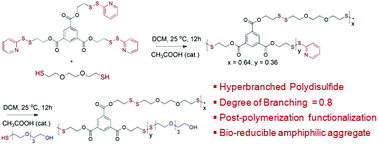Hyperbranched polydisulfides†
Abstract
Disulfide containing polymers have been extensively studied as responsive materials for biomedical applications such as drug delivery, gene delivery, bio-sensing and receptor-mediated cellular uptake due to the possibility of cleaving the disulfide linkage with glutathione (GSH), a tri-peptide overexpressed in cancer cells. While linear and branched polymers containing disulfide groups have been already studied and more recently polydisulfides (PDS) have come to the fore, hyperbranched polydisulfides (HBPDS) were not known. This manuscript for the first time reports a generally applicable methodology for synthesis of HBPDS by an A2 + B3 condensation approach. The B3 monomer contains three pyridyl-disulfide (Py–Ds) groups while a di-thiol compound serves as the A2 monomer. Polycondensation reaction under very mild reaction conditions produces HBPDS (Mw = 14300 g mol−1, Đ = 1.9) with a very high degree of branching (DB) value of 0.8 and more than twenty highly reactive Py–Ds groups present at the terminal or linear unit of a polymer on an average. The reactive Py–Ds groups can be completely replaced by post-polymerization functionalization using a hydrophilic thiol resulting in bio-reducible amphiphilic HBPDS. It produces micellar aggregates in water with a hydrodynamic diameter of ∼80 nm, a low critical aggregation concentration (7.0 μM) and a high dye (Nile red) loading content. The exchange dynamics of these micellar aggregates, studied by fluorescence resonance energy transfer (FRET), reveals practically no inter-micellar exchange after 6 h indicating very high non-covalent encapsulation stability. On the other hand, in the presence of glutathione, the PDS backbone can be degraded resulting in an efficient triggered release of the encapsulated dye. Dye release kinetics strongly depends on the GSH concentration and interestingly with a fixed concentration of glutathione the release kinetics appears to be much faster for the hyperbranched PDS micelle compared to its linear analogue. MTT assay with two representative cell lines indicates that the amphiphilic HBPDS is biocompatible up to 500 μg mL−1 which is further supported by hemolysis assay showing merely 6.0% hemolysis up to a polymer concentration of 500 μg mL−1.



 Please wait while we load your content...
Please wait while we load your content...